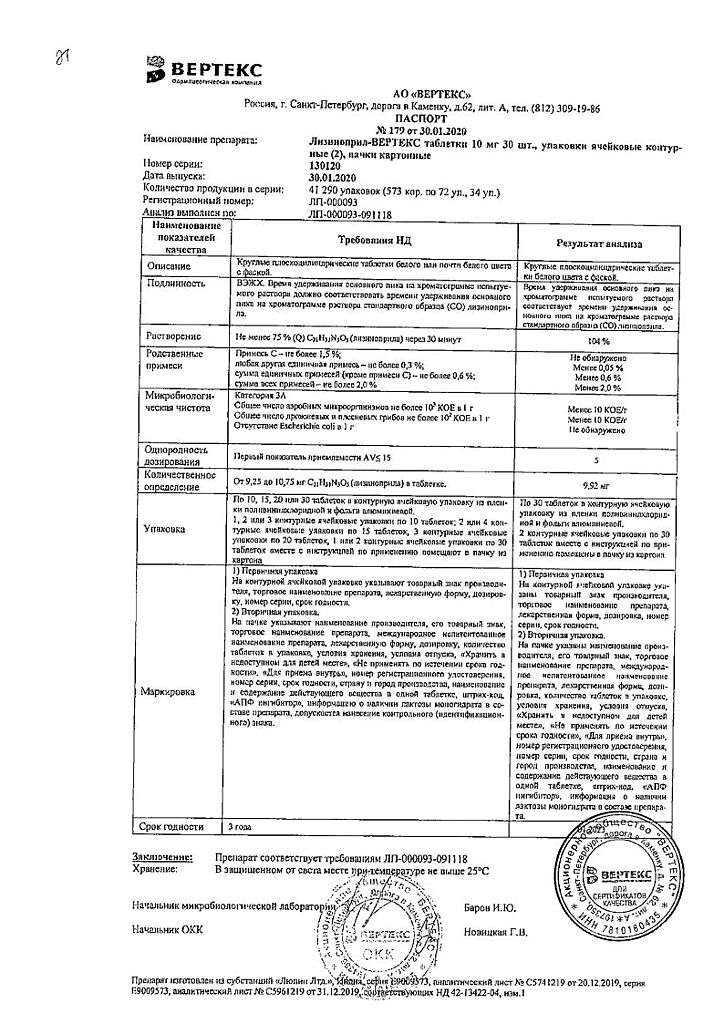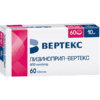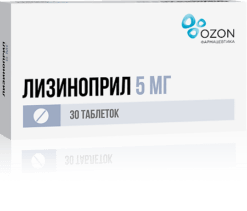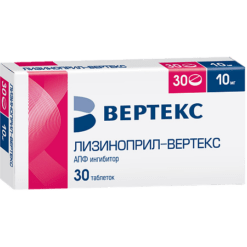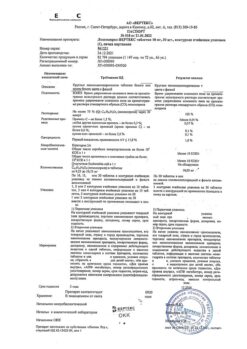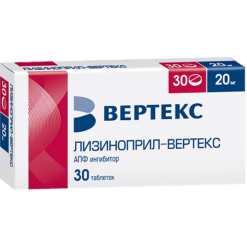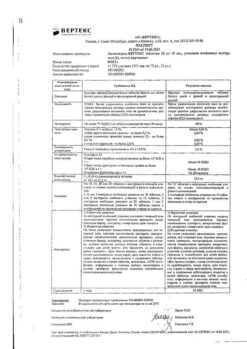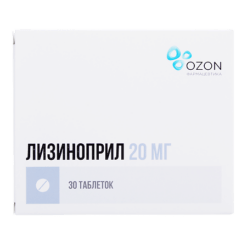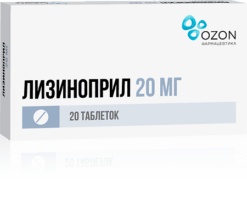No products in the cart.
Lisinopril-Vertex, tablets 10 mg 60 pcs
€6.55 €5.73
Description
A ACE inhibitor, reduces the formation of angiotensin II from angiotensin I. Reduction of angiotensin II leads to a direct reduction of aldosterone release. Reduces bradykinin degradation and increases prostaglandin synthesis.
Limits total peripheral vascular resistance, blood pressure (BP), preload, pulmonary capillary pressure, causes an increase in the minute blood volume and increases myocardial tolerance to exercise in patients with chronic heart failure.
Dilates arteries to a greater extent than veins. Some effects are explained by the effect on the tissue renin-angiotensin-aldosterone system. Long-term use reduces myocardial hypertrophy and resistive arterial wall hypertrophy. It improves the blood supply to the ischemic myocardium.
ACE inhibitors prolong life expectancy in patients with chronic heart failure and slow the progression of left ventricular dysfunction in patients who have had myocardial infarction without clinical manifestations of heart failure.
The onset of action is within 1 hour. Maximal antihypertensive effect is determined after 6-7 hours and sustained for 24 hours. With arterial hypertension the effect is noted in the first days after the start of treatment, a stable effect develops after 1-2 months. In case of abrupt withdrawal of the drug no marked increase in BP was noted.
In addition to decreasing BP, lisinopril decreases albuminuria. Lisinopril does not affect blood glucose concentration in diabetic patients and does not lead to increased incidence of hypoglycemia.
Indications
Indications
Arterial hypertension (in monotherapy or in combination with other antihypertensive drugs).
Chronic heart failure (as part of combination therapy for the treatment of patients taking cardiac glycosides and/or diuretics).
Early treatment of acute myocardial infarction as part of combination therapy (in the first 24 hours with stable hemodynamic parameters to maintain these parameters and prevent left ventricular dysfunction and heart failure).
Diabetic nephropathy (reduced albuminuria in patients with type 1 diabetes mellitus with normal blood pressure, and patients with type 2 diabetes mellitus with arterial hypertension).
Pharmacological effect
Pharmacological effect
An ACE inhibitor, reduces the formation of angiotensin II from angiotensin I. A decrease in the content of angiotensin II leads to a direct decrease in the release of aldosterone. Reduces the degradation of bradykinin and increases the synthesis of prostaglandins.
Reduces total peripheral vascular resistance, blood pressure (BP), preload, pressure in the pulmonary capillaries, causes an increase in minute blood volume and an increase in myocardial tolerance to stress in patients with chronic heart failure.
Dilates arteries more than veins. Some effects are explained by effects on the tissue renin-angiotensin-aldosterone system. With long-term use, hypertrophy of the myocardium and the walls of resistive arteries decreases. Improves blood supply to ischemic myocardium.
ACE inhibitors prolong life expectancy in patients with chronic heart failure and slow the progression of left ventricular dysfunction in patients who have suffered a myocardial infarction without clinical manifestations of heart failure.
The onset of action is after 1 hour. The maximum antihypertensive effect is determined after 6-7 hours and persists for 24 hours. In arterial hypertension, the effect is noted in the first days after the start of treatment, a stable effect develops after 1-2 months. With abrupt discontinuation of the drug, no pronounced increase in blood pressure was observed.
In addition to lowering blood pressure, lisinopril reduces albuminuria. Lisinopril does not affect the concentration of glucose in the blood in patients with diabetes and does not lead to an increase in cases of hypoglycemia.
Special instructions
Special instructions
Symptomatic hypotension
Most often, a pronounced decrease in blood pressure occurs with a decrease in circulating blood volume (CBV) caused by diuretic therapy, a decrease in sodium chloride in food, dialysis, diarrhea or vomiting. In patients with chronic heart failure with or without simultaneous renal failure, a pronounced decrease in blood pressure is possible.
Under strict medical supervision, Lisinopril should be used in patients with coronary heart disease, cerebrovascular insufficiency, in whom a sharp decrease in blood pressure can lead to myocardial infarction or stroke. Transient arterial hypotension is not a contraindication for taking the next dose of the drug.
When using the drug Lisinopril, some patients with chronic heart failure, but with normal or low blood pressure, may experience a decrease in blood pressure, which is usually not a reason to stop treatment.
Before starting treatment with the drug, if possible, the sodium content should be normalized and/or the blood volume should be replenished, and the effect of the initial dose of Lisinopril on the patient should be carefully monitored.
In case of renal artery stenosis (especially with bilateral stenosis or in the presence of stenosis of the artery of a single kidney), as well as with circulatory failure due to a lack of sodium ions and/or fluid, the use of the drug Lisinopril can lead to impaired renal function, acute renal failure, which is usually irreversible even after discontinuation of the drug.
In acute myocardial infarction
The use of standard therapy (thrombolytics, acetylsalicylic acid, beta-blockers) is indicated. Lisinopril can be used in conjunction with intravenous administration or with the use of therapeutic transdermal nitroglycerin systems.
Surgery/general anesthesia
During extensive surgical interventions, as well as when using other drugs that cause a decrease in blood pressure, Lisinopril, by blocking the formation of angiotensin II, can cause a pronounced, unpredictable decrease in blood pressure.
In elderly patients, the same dose leads to a higher concentration of the drug in the blood, so special care is required when determining the dose.
Since the potential risk of agranulocytosis cannot be excluded, periodic monitoring of the blood picture is required. When using the drug under dialysis conditions with polyacrylic-nitrile membranes, anaphylactic shock may occur, so either a different type of dialysis membrane or the prescription of other antihypertensive drugs is recommended.
Impact on the ability to drive vehicles and machinery
There is no data on the effect of the drug Lisinopril on the ability to drive vehicles and machines, used in therapeutic doses, however, it must be taken into account that at the beginning of treatment, arterial hypotension may develop, which can affect the ability to drive vehicles and work with potentially dangerous mechanisms, and dizziness and drowsiness may also occur, so caution should be exercised.
Active ingredient
Active ingredient
Lisinopril
Composition
Composition
1 tablet contains:
Active substance:
lisinopril dihydrate (equivalent to lisinopril) 10 mg,
Excipients:
milk sugar (lactose);
MCC;
starch 1500 (pregelatinized);
aerosil (colloidal silicon dioxide);
talc;
magnesium stearate.
Contraindications
Contraindications
Hypersensitivity to lisinopril or other ACE inhibitors.
History of angioedema, including during the use of ACE inhibitors.
Hereditary angioedema or idiopathic angioedema.
Pregnancy and lactation period.
Age up to 18 years (efficacy and safety have not been established).
Lactase deficiency, lactose intolerance, glucose-galactose malabsorption syndrome.
With caution
Severe renal dysfunction, bilateral renal artery stenosis or stenosis of the artery of a single kidney with progressive azotemia, condition after kidney transplantation, azotemia, hyperkalemia, aortic stenosis, hypertrophic obstructive cardiomyopathy, primary hyperaldosteronism, arterial hypotension, cerebrovascular diseases (including cerebrovascular insufficiency), coronary heart disease, coronary insufficiency, autoimmune systemic connective tissue diseases (including scleroderma, systemic lupus erythematosus); inhibition of bone marrow hematopoiesis; diet with limited salt; hypovolemic conditions (including as a result of diarrhea, vomiting); elderly, hemodialysis using high-flow, high-permeability dialysis membranes (AN69®).
Side Effects
Side Effects
The incidence of side effects is characterized as often (1%), rarely (1%).
The most common side effects: dizziness, headache, fatigue, diarrhea, dry cough, nausea.
From the cardiovascular system: often – marked decrease in blood pressure, orthostatic hypotension; rarely – chest pain, tachycardia, bradycardia, worsening symptoms of chronic heart failure, impaired atrioventricular conduction, myocardial infarction.
From the central nervous system: often – paresthesia, mood lability, confusion, drowsiness, convulsive twitching of the muscles of the limbs and lips, rarely – asthenic syndrome.
From the hematopoietic organs: rarely – leukopenia, neutropenia, agranulocytosis, thrombocytopenia, with long-term treatment – anemia (decrease in hemoglobin, hematocrit, erythropenia).
From the respiratory system: rarely – shortness of breath, bronchospasm.
From the digestive system: rarely – dryness of the oral mucosa, anorexia, dyspepsia, changes in taste, abdominal pain, pancreatitis, jaundice (hepatocellular or cholestatic), hepatitis.
From the skin: rarely – urticaria, itching, increased sweating, alopecia, photosensitivity.
From the genitourinary system: rarely – impaired renal function, oliguria, anuria, acute renal failure, uremia, proteinuria, decreased potency.
Laboratory indicators: often – hyperkalemia, hyponatremia; rarely – hyperbilirubinemia, increased activity of liver enzymes, hypercreatininemia, increased concentrations of urea and creatinine.
Allergic reactions: rarely – angioedema of the face, extremities, lips, tongue, epiglottis and/or larynx, skin rashes, itching, fever, false positive test results for antinuclear antibodies, increased erythrocyte sedimentation rate (ESR), eosinophilia, leukocytosis. In rare cases, intestinal angioedema.
Other: arthralgia/arthritis, vasculitis, myalgia.
Interaction
Interaction
When using the drug simultaneously with potassium-sparing diuretics (spironolactone, triamterene, amiloride), potassium preparations, salt substitutes containing potassium, cyclosporine, the risk of developing hyperkalemia increases, especially with impaired renal function, so they can be used together only with regular monitoring of the content of potassium ions in the blood serum and renal function.
The combined use of lisinopril with beta-blockers, slow calcium channel blockers (SCBCs), diuretics, tricyclic antidepressants/neuroleptics and other antihypertensive drugs increases the severity of the hypotensive effect.
Lisinopril slows down the elimination of lithium drugs. Therefore, when used together, it is necessary to regularly monitor the concentration of lithium in the blood serum.
Antacids and cholestyramine reduce the absorption of lisinopril in the gastrointestinal tract.
When used together with insulin and oral hypoglycemic agents, there may be a risk of developing hypoglycemia.
Nonsteroidal anti-inflammatory drugs (NSAIDs) (including selective cyclooxygenase-2 (COX-2) inhibitors), estrogens, and adrenergic agonists reduce the hypotensive effect of lisinopril.
With the simultaneous use of ACE inhibitors and intravenous gold preparations (sodium aurothiomalate), a symptom complex has been described, including facial flushing, nausea, vomiting and decreased blood pressure.
When used together with selective serotonin reuptake inhibitors, it can lead to severe hyponatremia.
Combined use with allopurinol, procainamide, and cytostatics can lead to leukopenia.
Overdose
Overdose
Symptoms (occur when taking a single dose of 50 mg): marked decrease in blood pressure, dry oral mucosa, drowsiness, urinary retention, constipation, anxiety, increased irritability.
Treatment: there is no specific antidote. Symptomatic therapy. Gastric lavage, use of enterosorbents and laxatives. Intravenous administration of 0.9% sodium chloride solution is indicated. In case of treatment-resistant bradycardia, the use of an artificial pacemaker is necessary. Monitoring of blood pressure and water and electrolyte balance is necessary. Hemodialysis is effective.
Storage conditions
Storage conditions
In a dry place, protected from light, at a temperature not exceeding 25 ºС.
Shelf life
Shelf life
2 years
Manufacturer
Manufacturer
Vertex, Russia
Additional information
| Shelf life | 2 years |
|---|---|
| Conditions of storage | In a dry, light-protected place at a temperature not exceeding 25 ºC. |
| Manufacturer | Vertex, Russia |
| Medication form | pills |
| Brand | Vertex |
Other forms…
Related products
Buy Lisinopril-Vertex, tablets 10 mg 60 pcs with delivery to USA, UK, Europe and over 120 other countries.



